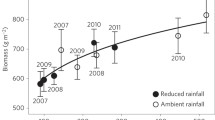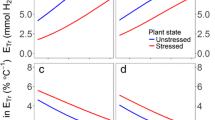Abstract
The increasing concentration of CO2 in the atmosphere should result in a general increase in the net primary productivity of most cultivated species and forest species, assuming no counterproductive climatic changes occur. The photosynthetic rate of C3 plants is most responsive to increasing concentration of CO2 in the ambient air. C4 plants demonstrate a stomatal closure that causes reduced transpiration. In the case of both types of plants, the water use efficiency (photosynthesis/transpiration) is likely to be improved.
It has been suggested that photosynthetic production may be limited today more by shortages of water and nutrients than by shortages of carbon dioxide. The author speculates that the inadvertant ‘CO2-fertilization’ now occurring could, in itself, cause a moderate release from these constraints.
Physiological responses to an increased atmospheric CO2 concentration are easily demonstrated in controlled environment studies. Because of the difficulty in maintaining artifically enriched air near the crop against the forces of turbulent transfer, studies in the open field have been inconclusive. The observation of decreased photosynthetic rate in a perennial crop during that part of the growing season when CO2 concentration is naturally low suggests a technique by which it may be possible to infer what will happen in the real world of agricultural fields if a CO2-rich environment, such as is predicted in the coming decades, materializes. Inferences from the very limited set of data available support the view that net photosynthetic production will be increased.
Similar content being viewed by others
References
Akita, S. and Moss, D. N.: 1972, ‘Differential Stomatal Response between C3 and C4 Species to Atmospheric CO2 Concentration and Light’,Crop Sci. 12, 789.
Allen, L. H. Jr., Desjardin, R. L., and Lemon, E. R.: 1974, ‘Line Source Carbon Dioxide Release. I. Field Experiment’,Agron. J. 66, 609.
Aoki, M. and Yabuki, K.: 1977, ‘Studies on the Carbon Dioxide Enrichment for Plant Growth, VII. Changes in th J.e Dry Matter Production and Photosynthetic Rate of Cucumber during Carbon Dioxide Enrichment’,Agr. Meteorol. 18, 475.
Baldocchi, D. D., Verma, S. B., and Rosenberg, N. J.: 1981a, ‘Seasonal and Diurnal Variation in the CO2 Flux and CO2-Water Flux Ratio of Alfalfa’,Agr. Meteorol. 23:281.
Baldocchi, D. D., Verma, S. B., and Rosenberg, N. J.: 1981b, ‘Environmental Effects on the CO2 Flux and CO2-Water Flux Ratio of Alfalfa’.Agr Meteorol. (in press).
Botkin, D. B., Janek, J. R., and Wallis, J. R.: 1973, ‘Estimating the Effects of Carbon Fertilization on Forest Composition by Ecosystems Simulation’, In G. M. Woodwell and E. V. Pecan (eds.),Carbon and the Biosphere. U.S. Atomic Energy Comm. 328–344.
Bolin, B.: 1970, ‘The Carbon Cycle’, InThe Biosphere, Freeman, San Francisco, pp. 47–56.
Brown, K. W., and Rosenberg, N. J.: 1971, ‘Energy and CO2 Balance of an Irrigated Sugar Beet Field in the Great Plains’,Agron. J. 63, 207.
Chapman, H. W., Gleason, L. S., and Loomis, W. E.: 1954, ‘The Carbon Dioxide Content of Field Air’,Plant Physiol. 29, 500.
Chollet, R.: 1977, ‘The Biochemistry of Photorespiration’,Trends Biochem. Sci. 2, 155.
Ehleringer, J. and Bjorkman, O.: 1977, ‘Quantum Yields for CO2 Uptake in C3 and C4 Plants’,Plant Physiol. 59, 86.
Goudriaan, J. and Ajtay, G. L.: 1979, ‘The Possible Effects of Increased CO2 on Photosynthesis’, In B. Bolin, E. T. Degens, S. Kempe, and P. Ketner (eds.),The Global Carbon Cycle (Scope 13), Wiley, New York, pp. 237–249.
Harper, L. A., Baker, D. N., Box, Jr. J. E., and Hesketh, J. D.: 1973, ‘Carbon Dioxide and the Photosynthesis of Field Crops: A Metered Carbon Dioxide Release in Cotton under Field Conditions’,Agron. J. 65, 7.
Jenny, H.: 1941,Factors of Soil Formation: A System of Quantitative Pedology, McGraw-Hill, New York, 281 pp.
Lemon, E. R.: 1976, ‘The Land's Response to More Carbon Dioxide’, In N. J. Anderson and A. Malahoff (eds.),The Fate of Fossil Fuel CO2 in The Oceans, Plenum Publ. Co., New York, pp 97–130.
Loomis, R. S.: 1977, CO2 and the Biosphere, Paper presented to the ERDA Workshop on Environmental Effects of Carbon Dioxide from Fossil Fuels Emission. Miami Beach, Florida, March 7–11, 1977. Mimeo 25 pp.
Loomis, R. S. and Gerakis, P. A.: 1975, ‘Productivity of Agricultural Ecosystems’, In J. P. Cooper (ed.),Photosynthesis and Productivity in Different Environments, IBP3, Cambridge Univ. Press, London, pp. 145–172.
Machta, L.: 1972, ‘Mauna Loa and Global Trends in Air Quality’,Bull. Amer. Meteorol. Soc. 53, 402.
Moss, D. N., Musgrave, R. B., and Lemon, E. R.: 1961, ‘Photosynthesis under Field Conditions, III. Some Effects of Light, Carbon Dioxide, Temperature and Soil Moisture on Photosynthesis, Respiration and Transpiration of Corn’,Crop Sci. 1, 83.
National Academy of Sciences/National Research Council/Climate Research Board.: 1979,Carbon Dioxide and Climate: A Scientific Assessment. Washington, D. C., 22 pp.
Verma, S. B. and Rosenberg, N. J.: 1976, ‘Carbon Dioxide Concentration and Flux in a Large Agricultural Region of the Great Plains of North America’,J. Geophys. Res. 81 399.
Verma, S. B. and Rosenberg, N. J.: 1979, ‘Agriculture and the Atmospheric Carbon Dioxide Buildup’.SPAN 22, 62.
Verma, S. B. and Rosenberg, N. J.: 1981, ‘Further Measurements of Carbon Dioxide Concentration and Flux in a large Agricultural Region of the Great Plains of North America’,J. Geophys. Res. 86, 3258.
Additional information
Published as Paper No. 6123, Journal Series, Nebraska Agricultural Experiment Station. The work reported was conducted under Regional Research Project 11–33 and Nebraska Agricultural Experiment Station Project 1149.
George Holmes Professor of Agricultural Meteorology, Center for Agricultural Meteorology and Climatology, Institute of Agriculture and Natural Sources, University of Nebraska-Lincoln, Lincoln, NE 68583, U.S.A.
Rights and permissions
About this article
Cite this article
Rosenberg, N.J. The increasing CO2 concentration in the atmosphere and its implication on agricultural productivity. Climatic Change 3, 265–279 (1981). https://doi.org/10.1007/BF02423219
Received:
Revised:
Issue Date:
DOI: https://doi.org/10.1007/BF02423219




